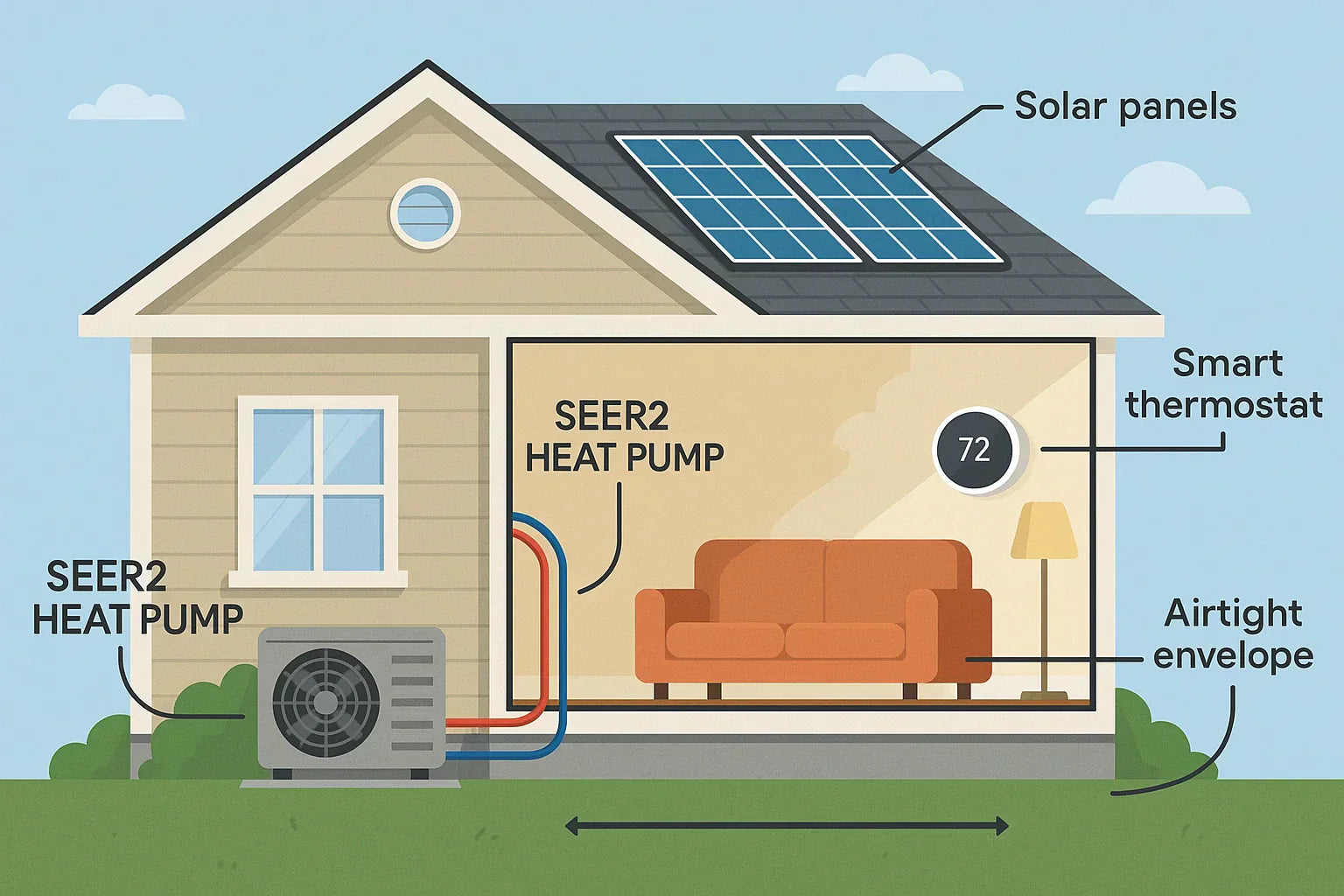Energy-efficient homes are no longer just a trend—they’re becoming the new standard. Whether you're aiming for net-zero status or looking to boost your home’s resale value with a green certification, your HVAC system plays a central role. But can upgrading to a high-SEER2-rated system actually help you get there?
Let’s explore how SEER2 ratings align with programs like ENERGY STAR, LEED, and Zero Energy Ready Homes—and whether making the jump to high-efficiency cooling is a smart move for your wallet and the planet.
📘 Want to brush up on SEER2 first?
👉 What is SEER2 and Why It Matters
What Qualifies as “Green” or “Net-Zero”?
Before diving into SEER2’s role, it’s important to understand what “green” or “net-zero” really means.
-
Green Certification typically refers to third-party recognition that a home meets a set of sustainable building practices—energy use, indoor air quality, and materials.
-
Net-Zero Energy means the home produces as much energy as it consumes annually, often with a combination of high-efficiency systems and renewable energy (like solar).
Popular certification programs include:
Each program has different criteria, but all share one thing in common: efficiency matters.
Why SEER2 Matters in Certification Programs
SEER2 (Seasonal Energy Efficiency Ratio 2) is the new standard used to rate how efficiently central ACs and heat pumps operate under real-world static pressure conditions. This makes it far more accurate than legacy SEER ratings.
Higher SEER2 systems:
-
Use less electricity
-
Reduce total home energy consumption
-
Align with new green building requirements
For example:
-
ENERGY STAR’s updated 2023+ HVAC guidelines now factor in SEER2 minimums: 14.3+ in most U.S. regions.
-
DOE’s Zero Energy Ready Homes require systems that meet or exceed ENERGY STAR specs—meaning high SEER2 is often a must.
Can SEER2 Alone Get You Certified?
Not quite—but it’s a critical part of the equation.
To qualify for most green or net-zero certifications, your home must excel in multiple areas:
-
HVAC Efficiency (SEER2, HSPF2, EER2 ratings)
-
Insulation & Air Sealing
-
Window and Door U-Values
-
Appliance & Lighting Efficiency
-
Renewable Energy Readiness
However, HVAC upgrades typically offer one of the best cost-to-impact ratios for hitting energy targets—especially when your current system is over 10 years old.
In short: SEER2 is not the whole story, but it’s a major chapter.
Benefits of Combining SEER2 and Certification
Upgrading to a high-SEER2 HVAC system and pursuing certification isn’t just for eco-enthusiasts. Here are some real-world benefits:
💰 Financial Incentives
Many local and federal programs offer rebates, tax credits, and green mortgage options for certified homes or high-efficiency upgrades.
➡️ Fannie Mae’s Green Financing Guide
🏠 Higher Home Resale Value
Studies show energy-efficient and certified homes sell faster and for more money. A SEER2-rated system becomes a selling point in tight housing markets.
📈 Improved HERS or Home Energy Score
These scores are often required for certifications. A new SEER2 unit can drastically lower your HERS Index or improve your DOE Home Energy Score.
🌎 Reduced Carbon Footprint
Lower energy consumption directly reduces emissions—especially if you’re using a clean electric grid or pairing HVAC upgrades with solar panels.
Case Study: Real-World Upgrade Path
Let’s take an average 2,000 sq. ft. home built in 2005 with an older 10 SEER central AC.
Scenario:
The homeowner replaces the unit with a 17.5 SEER2 variable-speed heat pump, adds attic insulation, and air-seals the crawlspace.
Results:
-
Annual HVAC energy use drops by 35%
-
HERS Index improves from 78 to 56
-
Home qualifies for local energy efficiency rebate
-
Becomes eligible for DOE Zero Energy Ready Home program
This isn’t a rare outcome—it’s becoming the norm as cities tighten energy codes and utility companies reward efficient upgrades.
Is It Worth the Effort?
If you’re already planning a system replacement, installing a SEER2-rated unit can bring you within reach of green certification—with minimal additional cost.
When it makes the most sense:
-
You're building new or doing a full retrofit
-
You're adding solar or battery storage
-
You want to lock in long-term energy savings and comfort
-
You plan to sell or refinance in the next 5–10 years
Certification isn’t just a badge—it opens the door to rebates, better financing, and long-term ROI.
Final Thoughts from Alex Lane
Here’s the bottom line: SEER2 won’t automatically certify your home—but it can absolutely tip the scales in your favor.
If you’re serious about going green or aiming for net-zero, ask your contractor:
“Will this system help me meet ENERGY STAR or LEED requirements?”
That simple question could lead to thousands in savings—and a healthier, more valuable home.
👉 Ready to circle back to where SEER2 knowledge begins?
📘 How to Decode SEER2 Rating Labels on New HVAC Equipment
Alex Lane
Your Home Comfort Advocate







